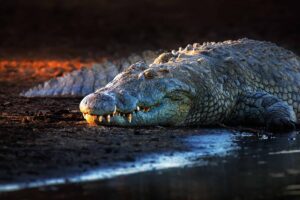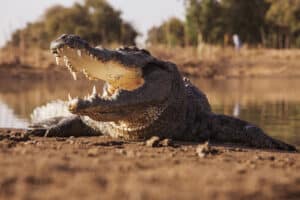Reptiles and mammals are easy to tell apart, but what is the difference between a reptile and an amphibian? Is a crocodile a reptile, or is it an amphibian? We know it is not a fish (although it spends time in the water) and definitely not a bird (no feathers, can’t fly). So, what makes a reptile a reptile, and what is a crocodile?
What Is A Reptile?
There are a few characteristics that all (or most) reptiles have in common. All reptiles are vertebrates, meaning they have a backbone. Reptiles are also cold-blooded; they regulate their temperature based on their surrounding environment. Amphibians are vertebrates and are cold-blooded too. So, what makes them different? That is about all the two have in common. Reptiles breathe with lungs, amphibians with gills and lungs. Reptiles have scales, and amphibians do not. Let’s take a look at some of the characteristics of reptiles and run the crocodile through the reptile test!
Are Crocodiles Vertebrates?

Crocodiles are vertebrates. Their backbone includes their long powerful tail.
©ShutterOK/Shutterstock.com
Crocodiles are vertebrates and have a long backbone that includes their tail. The largest crocodiles can grow to be 16-18 feet long, some even reaching 20 feet. Their tails, which are part of their backbone, are very muscular and are used to propel them through the water. They can even use their tail to jump out of the water. If an unsuspecting zebra comes to a waterhole for a drink, a crocodile can use its tail to launch at it and drag it into the water, rolling it over (“death roll”) until it dies.
Are Crocodiles Cold-Blooded?
Cold-blooded animals cannot make their heat. Their temperature is the same as the temperature around them. If it is 90° on a sunny afternoon in the swamp, the crocodile’s temperature would be 90°. Cold-blooded animals have to move to different places in their habitat to adjust their temperature. If the water a crocodile is swimming in starts to get too cold, it can leave the water and lay on the riverbank in the sun. That is why you may see a group of crocodiles basking in the sun together. If you see one with its mouth open, it is not a lazy hunter waiting like a Venus flytrap. It is simply using this technique to cool off just a little, like tweaking the thermometer. Crocodiles prefer a temperature between 86°-91°.
Do Crocodiles Breathe With Lungs?
Yes, crocodiles have lungs. Think about a great white shark and its visible gills on the side. Crocodiles do not have gills. They breathe oxygen in the same way humans do. Crocodiles have a four-chambered heart that pumps oxygenated blood throughout its body. One difference about crocodiles is that they have an adaptation to stay underwater for an hour or more! Their heart rate can slow to 2-3 beats a minute and conserve energy, not needing as much oxygen.
Do Crocodiles Have Scales?
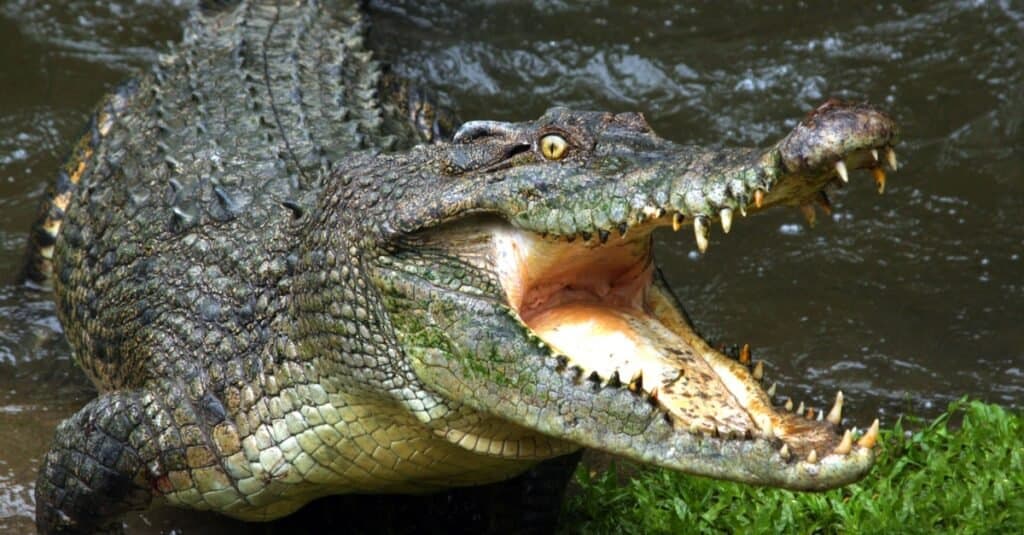
Crocodiles have tough scales all over their bodies.
©Audrey Snider-Bell/Shutterstock.com
Yes, crocodiles have tough scales that protect them from predators and other crocodiles. The scales overlap and are made of keratin, like our hair and fingernails.
Do Crocodiles Shed Their Skin?
Crocodiles shed their skin, but not all at once. If you think about a snake shedding its skin, you can find a nearly intact snakeskin that looks just like a snake just slithered out of it. Crocodiles are different and shed individual scales or a few scales at a time.
Do Crocodiles Have Four Legs?
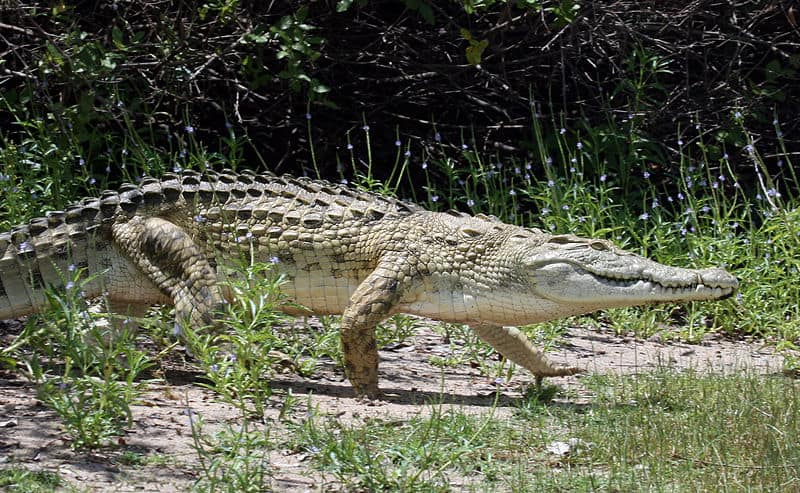
Crocodiles spend most of their time in the water but can walk and even run on land.
Yes, crocodiles have four legs and powerful ones as well. Crocodiles are good swimmers and faster on land than you would think. They spend most of their lives in the water or basking in the sun on the shore, but they can run 15-22mph in short bursts if they need to. An average galloping speed of 7-10mph is more common. Their strong legs help propel them in the water as well.
Do Crocodiles Lay Eggs?
Yes, crocodiles lay eggs. Dwarf crocodiles lay 10-20 eggs. American crocodiles lay 30-60 eggs, and saltwater crocodiles lay 40-60 eggs. Crocodile eggs have a leathery shell. Sometimes, they will lay them all in one nest or a few nests in the same location. Mother crocodiles will lay their eggs in holes and cover them or create a mound around the nest to keep the eggs warm. She sticks around to keep an eye on the nest and then digs the eggs out when it is time to hatch. Crocodile mothers carry their babies in their mouths to the nearest water source. Conservationists in Florida are tracking the number of American crocodiles and are pleased that the number increases each year.
It’s A Boy! It’s All Boys!
Researchers discovered that the temperature of the eggs in the nest determines the sex of the crocodiles. If the temperature is warm, around 34° C (93° F), all the eggs will hatch males. If the temperature is a little cooler, around 30° C (86° F), all the eggs will hatch females.
Are Crocodile Skulls The Same As Other Reptiles?
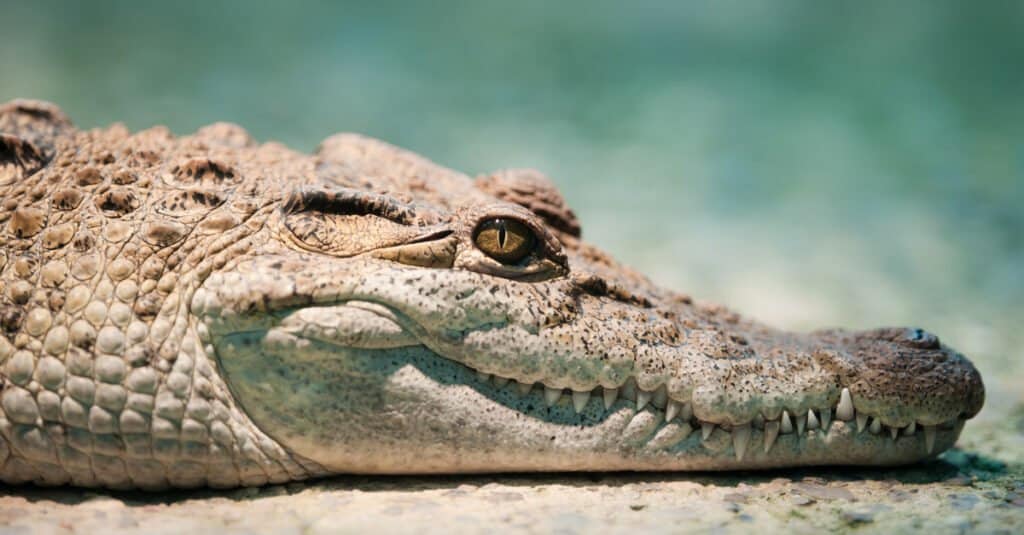
Crocodiles have teeth on the upper and lower jaws. They can have 80 teeth at one time!
©Peter Wey/Shutterstock.com
The skulls of crocodiles are different from snakes because crocodiles have a single row of teeth on the top jaw and lower jaw. Snakes have teeth on their palatal bone (a bone on the roof of the mouth) and the upper and lower jaw. Think about a rattlesnake’s fangs, for example. Non-venomous snakes do not have fangs, but most have teeth. Crocodile skulls have two openings on either side of their head. The crocodile has a longer, skinnier snout on the skull compared to the alligator. Now I know why they say, “Smile, crocodile!” Crocodiles have 80 teeth! They can regrow them when they fall out.
Do Crocodiles Eat Meat?
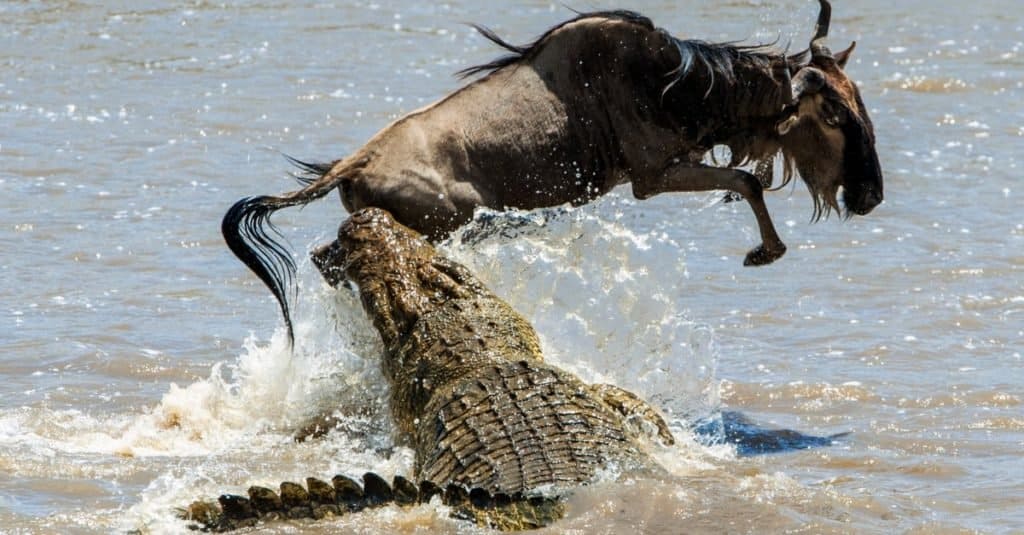
Crocodiles are carnivores. They eat fish, birds, crustaceans, and sometimes big animals.
©Sergey Uryadnikov/Shutterstock.com
Yes, crocodiles eat meat. They are carnivores and feast on many animals that come near the water’s edge. Crocodiles eat fish, birds, crustaceans, small mammals, and in some countries, zebra and wildebeest.
Do Crocodiles Eat Rocks?
Yes, crocodiles eat rocks. They eat rocks to help with digestion. There is actually a name for a rock that has been in the digestive system of an animal. That rock is called a gastrolith. Not all reptiles eat rocks, but rocks play an important role in digestion for crocodiles since they cannot chew with their teeth. Other animals that eat rocks are chickens, ostriches, penguins, seals, and toothed whales. Snakes do not eat rocks because they have heavy-duty acids and enzymes in their stomachs that break down their food.
Are Crocodiles Reptiles?
Yes, crocodiles are reptiles. They have some odd habits, but they are reptiles.
The photo featured at the top of this post is © Gaston Piccinetti/Shutterstock.com
Thank you for reading! Have some feedback for us? Contact the AZ Animals editorial team.




